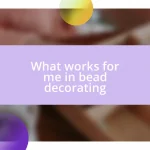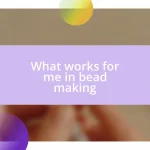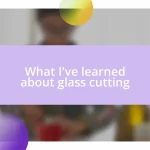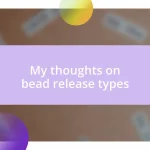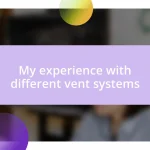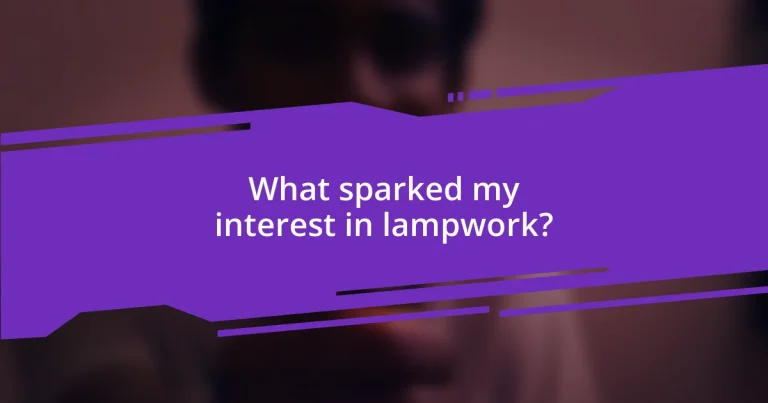Key takeaways:
- The author’s journey in lampworking began at an art fair, ignited by a connection with glass and the skill of a glass artist.
- Experiencing various lampwork techniques and types of glass has deepened the author’s creativity and emotional connection to their art.
- Building a supportive community through workshops and gatherings has enriched the author’s artistic journey, fostering collaboration and shared passion.
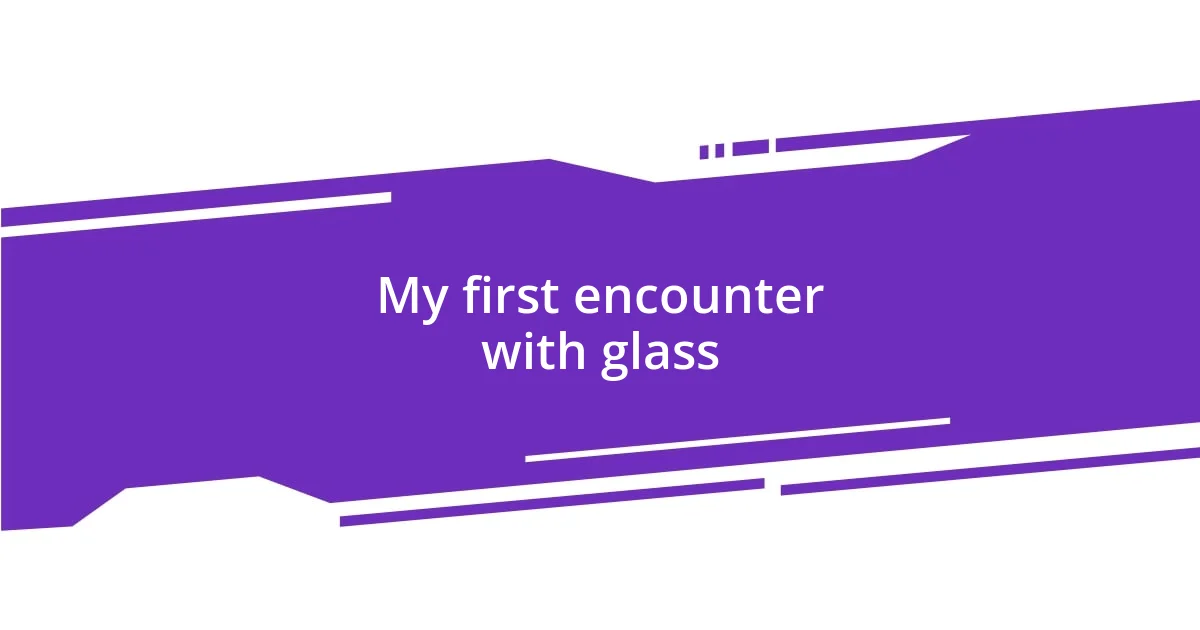
My first encounter with glass
I still vividly recall the moment I first laid eyes on glass, shimmering in the sunlight like a jewel. I was wandering through an art fair, completely unaware that this simple material would change the course of my creative journey. Have you ever felt that instant connection with something, as if it was calling out to you?
I remember walking up to a stall where a glass artist was demonstrating their craft. The way they manipulated the glass with such finesse mesmerized me. It was captivating to see how something so fragile could transform into beautiful shapes right before my eyes. Watching the colors meld and dance, I felt a rush of inspiration—could I ever create something like that?
That day, I left the fair with a small, delicate glass bead. Holding it in my hand, I felt a surge of excitement and curiosity. It was more than just a bead; it was a reminder of the beauty of creation and the endless possibilities that glass offered. Was it just a coincidence that my journey in lampwork began with that one small moment? I think not. It was the spark I didn’t know I was looking for.

Understanding lampwork techniques
Understanding lampwork techniques opens a fascinating world of possibilities for any aspiring glass artist. The tools and methods vary widely, each offering a unique approach to crafting mesmerizing glass pieces. I remember my first attempt at shaping glass—holding the torch felt both empowering and terrifying. The flame flickered like a dancer, and as I heated the glass, I felt a thrill coursing through me, realizing that I could create with my own hands.
Here are some fundamental lampwork techniques to consider:
- Stringer Work: Manipulating fine strands of glass to create intricate designs.
- Marvering: Rolling hot glass on a smooth surface to refine its shape.
- Encasing: Layering glass over other colors to enhance depth and detail.
- Rimming: Adding decorative edges to beads for a polished finish.
- Puffing: Creating hollow shapes by introducing air into molten glass.
Each technique transforms the glass in distinct ways, allowing for endless creativity. Each time I used one of these methods, I felt a rush of excitement as I watched my visions take form. It’s not just about the product; it’s about the journey of creation itself.
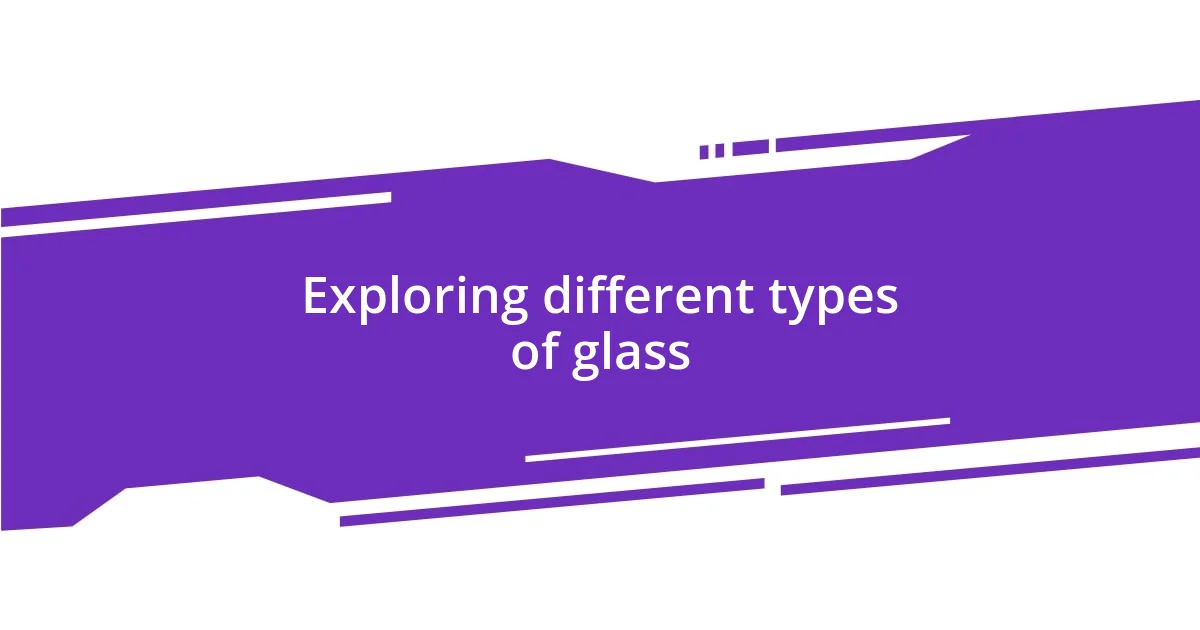
Exploring different types of glass
Exploring different types of glass has truly been a delightful adventure in my lampworking journey. I initially thought that glass was just glass, but as I delved deeper, I realized that the variety is astounding. For example, the difference between soda-lime glass and borosilicate glass is significant in terms of melting point and durability. I still remember my first attempt with borosilicate; the moment I struck the flame, I felt a shift in my understanding of glass’s possibilities, and it sparked an endless curiosity within me.
In the realm of glass types, color also plays an incredibly crucial role. Certain glasses respond beautifully to heat, changing color or becoming translucent, while others hold their tone steadfast under flame. I learned that spending time observing these reactions is just as important as the actual shaping process. It’s like an intricate dance, where each glass behaves differently. I clearly recall when I worked with a striking glass that shifted hues right as I began to sculpt it. The transformation was so remarkable that I couldn’t contain my excitement—every change in color became a reason to experiment and explore further.
Ultimately, understanding glass types is not merely an academic pursuit; it’s a deeply personal journey. The characteristics of each glass type often resonate with my emotional state during my creative process. I find that working with certain colors or styles of glass can set the mood for my creations. For example, when I choose vibrant colors, I feel energized, while softer hues tend to lead me to more contemplative designs. This connection between my mood and the glass I select adds another layer to my lampworking experience, bringing my emotions to life through my art.
| Type of Glass | Characteristics |
|---|---|
| Soda-Lime Glass | Commonly used, affordable, easy to work with. |
| Borosilicate Glass | More durable, withstands higher temperatures; great for intricate work. |
| Fusing Glass | Ideal for kiln work; can be melted together for larger pieces. |
| Crystal Glass | High refractive index, often used in fine art and jewelry. |

Learning from experienced lampworkers
Learning from experienced lampworkers has been an invaluable part of my journey. I vividly remember my first workshop with a seasoned artist, watching their hands dance gracefully over the flame. It was mesmerizing! Here I was, a novice with shaky hands, but their confidence instilled a sense of hope in me. They didn’t just teach techniques; they shared their passion and stories, making the art of lampworking feel like a shared secret.
What struck me the most was how these experienced lampworkers encouraged experimentation. They would often say, “Mistakes are just happy accidents waiting to happen.” This mindset helped me embrace my creativity without fear. Once, I accidentally mixed two colors that I thought would clash horrendously. Instead, the outcome was a vibrant pop that I still incorporate in my work today. Their wisdom made me realize that every flame can lead to unexpected beauty.
Reflecting on the personal mentorship I’ve received, it’s clear that the relationships I’ve built with these talented artists have shaped not just my skills, but my entire outlook on art. Their enthusiasm was infectious, making me ask myself, “What if I pushed my boundaries even more?” I’ve learned to ask questions, seek advice, and share my own journey, creating a community where we all grow together—an enriching experience that goes beyond just learning lampwork techniques.

Attending lampwork workshops and classes
Attending lampwork workshops has truly opened my eyes to the charm of this art form. I remember my first class vividly; the excitement in the air was palpable as we gathered around the torches. Each station had its own unique setup, and I felt like a kid in a candy store! With guidance from our instructor, I was able to create my first bead, and the sense of accomplishment was indescribable. That spark ignited a passion that I still carry to this day.
What I found most enlightening was the community aspect of these workshops. Sharing tips and tricks with fellow students created an atmosphere of collaboration that was incredibly motivating. I recall one session where we held a friendly competition to see who could create the most intricate design within a time limit. The laughter and camaraderie made the experience so memorable! Don’t you find that collaborative environments often elevate the learning experience? This sense of community has become one of my favorite aspects of attending workshops, as it fuels creativity and inspires experimentation.
One of the most impactful moments for me occurred during a more advanced class focused on sculptural techniques. A fellow student walked in with a jaw-dropping piece of work that truly showcased the wonders of lampwork artistry. It wasn’t just the piece itself; it was the story behind it that inspired me deeply. Listening to her journey made me wonder, “What stories do my creations tell?” This simple question pushed me to create with intention, making my lampworking journey not just about the process, but also about exploring the narratives behind each piece I craft.
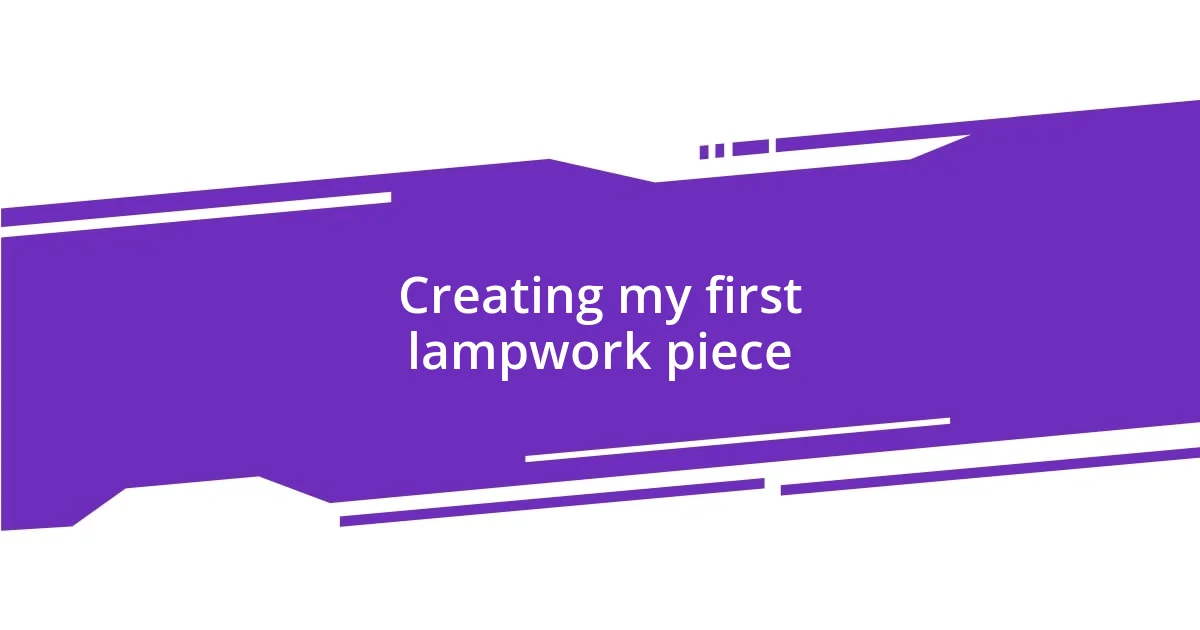
Creating my first lampwork piece
Creating my first lampwork piece was equally thrilling and nerve-wracking. I recall the moment I sat in front of the torch, my heart racing with anticipation. As I melted the glass rod, I felt both a sense of power and vulnerability. Would it crack? Would I even be able to shape it? That first bead I created looked far from perfect, but it was mine. The instant it emerged from the flame, I realized I had captured a tiny piece of magic in my hands.
Interestingly, the process taught me more than just technical skills; it opened a door into my own creative psyche. In the beginning, I was unsure, even timid, about my artistic instincts. But as the molten glass began to take shape under my hands, I remembered a phrase I had learned in a workshop: “Let your hands do the talking.” Suddenly, it felt less about following a formula and more about expressing who I was in that moment. Isn’t it fascinating how art can become a mirror reflecting our innermost thoughts?
As I examined my first creation closely, I found that it was more than a simple bead; it spoke of my journey—every shaky movement in that glass told a story of resilience. I still keep that bead as a reminder of where I started, a little token of courage. Each subsequent piece reminds me that growth is a journey; you start rocky, but with every attempt, you develop a unique voice. Can you recall a moment that sparked your creative journey? I cherish those moments, as they remind us of the beauty inherent in every new adventure.

Building a community in lampworking
Building a community in lampworking has been a journey filled with shared experiences and invaluable connections. I remember my first encounter at a local gathering, surrounded by artists from various skill levels. Everyone was eager to swap stories about their favorite techniques and challenges. It struck me how open and welcoming the lampworking community is; each dialogue not only enriched my knowledge but also deepened my passion for the craft.
What’s truly special is the encouragement that flows through these gatherings. I once took part in a potluck where attendees brought their latest creations to share. The elation in exchanging feedback was unlike anything I’d experienced before. I couldn’t help but think: how often do we find spaces where our creativity is uplifted rather than judged? This sense of support fosters not just technical skills but also emotional growth as we all navigate the ups and downs of our artistic journeys together.
Additionally, online platforms have become a vital extension of this community, allowing artists to connect across distances. I remember posting a picture of one of my pieces and receiving an outpouring of encouragement and constructive advice. It made me realize: even when physically separated, we can still cultivate connections that inspire and elevate our craft. How powerful is it to know that there’s a whole world of lampworkers cheering us on, no matter where we are? Such communal bonds are the heart of lampworking, reminding us that art can be as much about connection as it is about creation.


